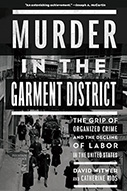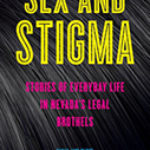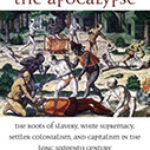Murder In The Garment District: The Grip Of Organized Crime And The Decline Of Labor In The United States

Authors: David Witwer and Catherine Rios
Publisher: New York: The New Press, 2020. 304p.
Reviewer: James Finckenauer | September 2020
At the heart of this examination of the relationship between labor and organized crime by David Witwer and Catherine Rios is the history of the role of labor unions. Reading this book led me to think about my own views of labor unions, and why I might have held – and to some degree still hold — those views. In brief conversations with friends as sort of an informal check, I find that they, like me, also have a somewhat jaundiced view of labor unions. Why is that? Murder in the Garment District goes a long way in answering this question. That I and my friends are not unusual in holding this somewhat negative view is reflected in Witwer and Rios’ observation that public opinion polls since the 1970s find that majorities of those polled “believed many union leaders had known ties to organized crime and racketeers, were not to be trusted to tell the truth, and abused union funds” (p. 236).
Having a “jaundiced view” is thus a benign way of saying that unions have often been associated with criminals and racketeers, with corruption, and also with communists. And, as Witwer and Rios make clear, in the case of too many unions those associations have been real. The authors detail the history of such connections, and in the case of crime and corruption in particular, link unionism to a particular view of ethics and morals that seemed to characterize many people involved in the union movement. Referring to the work of W. Michael Reisman, for example, the authors write: “Corruption proliferates not because individuals stop caring about the difference between right and wrong, but because they observe a different, real-world standard of behavior for people in their situation….they are adhering to an ‘operational code’….” (p. 54). In this regard, they cite George Meany (former President of the AFL/CIO) as recognizing that there are “gray areas of conduct” and that “unionists operated in a real-world context where getting things done often involved cutting moral corners” (p. 209). This perspective reflects a situational ethics view where the end is seen to justify the means. It is a perspective that justifies corruption just about anywhere in the world where it exists – which is nearly everywhere! The rationale: “I know this is probably wrong, and I would not do it otherwise, but I have to do what I have to do!” To see that this stance is not unique to unionists, one need only think about the recent scandal involving celebrities and other wealthy individuals paying (bribing) university personnel, and faking credentials, etc. to insure college admission for their sons and daughters.
In this well-researched treatise (there are 38 pages of notes), Witwer and Rios delve into the labor union connections to organized crime and racketeering, and to communism, and describe the roles of many of the big-name players in creating that history. These include Walter Reuther, Jimmy Hoffa, George Meany, etc. from the union ranks, journalists such as Victor Riesel, and from the world of investigators, Senator John McClellan and his legal counsel, Robert F. Kennedy. But the authors’ history is kicked off by the murder of a little-known union organizer for the International Ladies’ Garment Workers’ Union (ILGW) named William Lurye on May 9, 1949 in New York City’s Garment District. It is indeed this particular murder that is the murder of the title of the book.
The killing of William Lurye was just one tiny piece of evidence of mob infiltration and influence and of the menace of labor racketeering. Witwer and Rios trace organized crime’s involvement through a number of unions over a number of years. Why that came about seems in one respect to be actually quite simple. Employers and businesses producing goods and/or services wanted (and still want) to do so at the lowest possible expense so as to maximize their profits. To do this they must keep their labor costs as low as possible. If, however, employees become unionized, employers can expect their costs for labor and benefits to go up, thus reducing their profit margin. Thus, it is in the interests of employers to keep their employees from having a union. How do they keep a union out? What happened to Mr. Lurye is one extreme example. But employers who are businessmen do not want to do this sort of dirty work themselves, so they hire others to do it for them. Therefore, according to the authors, “providing … access to non-union contractors, or making it possible for contractors to operate on a non-union basis [became] a lucrative source of revenue for gangsters” (p. 74). This helps explain one side of the story, but what about the union side? How and why did unions get themselves hooked up with gangsters?
The justice system response to the Lurye murder is instructive here. Witwer and Rios point to corruption in the NYPD, and to the shady dealings of then NYC Mayor William O’Dwyer, as hamstringing the handling of Lurye’s case, and convincing the ILGW that they could not depend on law enforcement to protect them and their interests. Consequently, they reached an accommodation with organized crime – what became labeled “accommodation racketeering,” ala the ends/means issue mentioned above. The ILGW was not alone in this. Some union leaders, the authors write, abused their positions and made accommodations with organized crime groups which then led to labor racketeering. The authors point out that it was particularly in industries where organized crime had already established a role that unionists encountered the moral dilemma mentioned above. In trucking and in construction, for example, both union members and employers had to make what Witwer and Rios call “pragmatic arrangements with organized crime figures.” Perhaps the best known and most notorious example of this practice involved the International Brotherhood of Teamsters and its president at the time, one Jimmy Hoffa. But before touching on some of the major players in this story, like Hoffa, let us look briefly at the other seemingly nefarious connection involving unions, namely that with communism.
Here too the book describes an interesting history having a variety of threads. For example, in the early 1930s, Walter Reuther, who ultimately became the head of the United Auto Workers union, spent eighteen months working (along with his brother) in an auto plant in the Soviet Union. This was at a time in the 1920s-1930s when socialism and communism were viewed very favorably in some circles in the U.S. Reuther and other labor leaders, while rejecting some aspects of the Soviet system, nevertheless saw the value and the potential of having an organized and mobilized labor movement, and worked aggressively to bring that about. In some cases, this included an affiliation with the Communist Party USA. Somewhat ironically, as the authors point out, over time Reuther actually became a staunch anti-communist, but many political conservatives continued to view him as being dangerous to the free enterprise system given his early history.
Another thread linked to communism involves the murdered William Lurye’s sister, Min Lurye Matheson. William and Min’s parents – their father was a revolutionary who fled tsarist Russia in the early 1900s – were radical socialists. Min herself joined the Young Workers’ Communists League and later the Communist Party USA, but then dropped out when she became disillusioned with what was happening with the party and unions. She and a number of other CPUSA members or former members were subsequently active in the ILGW union. And there were others with current or past communist affiliations that were active in other unions as well. As a consequence, a definite linkage appeared in union movement circles between communism and certain labor unions. In the 1950s, during the communist hunting era of McCarthyism, this so-called communist infiltration of the labor movement – along with the even more obvious issue of labor racketeering – became viewed as domestic threats to the national security of the country. It was during that decade that reputations were made in exposing and dealing with those threats.
In addition to discussing the roles of various labor leaders and their connections to racketeering and/or communism, Witwer and Rios also take up the myriad investigations into these leaders and their variable connections. These investigations were mainly of two types – those conducted by investigative journalists, and those conducted by various government entities, in particular the United States Senate.
The authors describe in considerable detail the work of Victor Riesel as an example of the part the press played in exposing the underside of organized labor. In a newspaper column, Riesel wrote about the murder of William Lurye as being indicative of organized crime “muscling in on the unions.” Riesel’s widely publicized warnings about the infiltration of labor unions by communists and racketeers made him one of the most prominent figures taking up this cause. But as Witwer and Rios describe in detail, Riesel’s visibility ultimately lead to the following: “In the early morning hours of April 5, 1956, as Victor Riesel was leaving Lindy’s restaurant in Manhattan, a hired thug approached him and threw a vial of concentrated sulfuric acid into his face….Riesel was left permanently blind” (p. 139). I was familiar with this part of the Riesel story, but what I was not familiar with was what these authors go on to call “a more complicated story.” The attack on Riesel did indeed lead to widespread calls for government action against labor racketeering, including from then President Eisenhower. The Senate’s Permanent Subcommittee on Investigation (PSI) took up the cause and was the most prominent of the investigative actions. But back to the “more complicated story.” In sum, Witwer and Rios conclude that Riesel’s account of the attack on him was dishonest. Not that he was not blinded in the fashion described, but rather, in their words, “almost every aspect of what the public had been led to believe about the story behind [emphasis mine] the acid attack was not true” (p. 151). This tale alone was almost worth the price of admission for me!
It was the Senate PSI that illustrates the roles of two other major players in the overarching story Witwer and Rios tell. Senator John McClellan, who chaired the committee, led what the authors call the largest congressional investigation of its kind – extending over two and a half years – and engraved two names into public consciousness: McClellan himself, who added to his stature of already being a powerhouse of the Senate; but especially that of the chief counsel of the committee, Robert F. Kennedy. It was in the hearings of this committee that Kennedy first embarked on what became his lengthy war with Jimmy Hoffa, and made his reputation as being a zealous (some say overzealous) fighter against corruption and organized crime. From this foundation, Kennedy went on to be attorney general, senator, and finally, tragic presidential candidate.
In considering whether I really wanted to review Murder in the Garment District, I had some trepidations. My thought was I was going to learn more about organized labor and unions than I ever wanted to know. And in truth, there is some of that in this book. On the other hand, Witwer and Rios tell a compelling and well-written story that has ramifications that extend beyond the immediate subject, e.g., how and why corruption as well as organized crime exist more generally. I recommend reading it!
James O. Finckenauer, PhD, Distinguished Professor Emeritus


